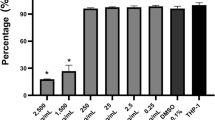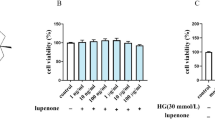Abstract
Aim:
Recent studies have shown that constitutive activation of the nuclear factor κB (NF-κB) plays a key role in chronic inflammation and cancers. The aim of this study was to characterize lobolide, a cembrane diterpene, as a drug candidate targeting the NF-κB signaling pathway.
Methods:
A HEK 293/NF-κB-Luc stable cell line was constructed to evaluate the effect of lobolide on NF-κB activation. THP-1 human monocytes and peripheral blood mononuclear cells (PBMCs) from healthy volunteers were tested. Lipopolysaccharide (LPS)-induced TNFα and IL-1β production and activation of the TAK1-IKK-NF-κB pathway were studied using ELISA and Western blot analysis.
Results:
In HEK 293/NF-κB-Luc stable cells, lobolide (0.19–50 μmol/L) inhibited NF-κB activation in a concentration-dependent manner with an IC50 value of 4.2±0.3 μmol/L. Treatment with lobolide (2.5–10 μmol/L) significantly suppressed LPS-induced production of TNFα and IL-1β in both THP-1 cells and PBMCs. In THP-1 cells, the suppression was partially caused by blockade of the translocation of NF-κB from the cytoplasm to the nucleus via affecting the TAK1-IKK-NF-κB pathway and p38 and ERK MAPK activity.
Conclusion:
Lobolide is a potential inhibitor of the NF-κB pathway, which blocks the translocation of NF-κB from the cytoplasm to the nucleus. Lobolide inhibits LPS-stimulated TNFα and IL-1β release, suggesting that the compound might be an anti-inflammatory compound.
Similar content being viewed by others
Log in or create a free account to read this content
Gain free access to this article, as well as selected content from this journal and more on nature.com
or
References
Vane JR, Flower RJ, Botting RM . History of aspirin and its mechanism of action. Stroke 1990; 21: IV12–23.
Wright V . Historical overview of NSAIDs. Eur J Rheumatol Inflamm 1993; 13: 4–6.
Frolich JC . A classification of NSAIDs according to the relative inhibition of cyclooxygenase isoenzymes. Trends Pharmacol Sci 1997; 18: 30–4.
Simon LS . Role and regulation of cyclooxygenase-2 during inflammation. Am J Med 1999; 106: 37S–42S.
Suleyman H, Demircan B, Karagoz Y . Anti-inflammatory and side effects of cyclooxygenase inhibitors. Pharmacol Rep 2007; 59: 247–58.
Kiefer JR, Pawlitz JL, Moreland KT, Stegeman RA, Hood WF, Gierse JK, et al. Structural insights into the stereochemistry of the cyclooxygenase reaction. Nature 2000; 405: 97–101.
Lazzaroni M, Bianchi Porro G . Gastrointestinal side-effects of traditional non-steroidal anti-inflammatory drugs and new formulations. Aliment Pharmacol Ther 2004; 20: 48–58.
Burdan F, Szumilo J, Klepacz R, Dudka J, Korobowicz A, Tokarska E, et al. Gastrointestinal and hepatic toxicity of selective and non-selective cyclooxygenase-2 inhibitors in pregnant and non-pregnant rats. Pharmacol Res 2004; 50: 533–43.
Warner TD, Giuliano F, Vojnovic I, Bukasa A, Mitchell JA, Vane JR . Nonsteroid drug selectivities for cyclo-oxygenase-1 rather than cyclo-oxygenase-2 are associated with human gastrointestinal toxicity: a full in vitro analysis. Proc Natl Acad Sci U S A 1999; 96: 7563–8.
Ray WA, Stein CM, Daugherty JR, Hall K, Arbogast PG, Griffin MR . COX-2 selective non-steroidal anti-inflammatory drugs and risk of serious coronary heart disease. Lancet 2002; 360: 1071–3.
Baldwin AS Jr . The NF-kappa B and I kappa B proteins: new discoveries and insights. Annu Rev Immunol 1996; 14: 649–83.
Cordle SR, Donald R, Read MA, Hawiger J . Lipopolysaccharide induces phosphorylation of MAD3 and activation of c-Rel and related NF-kappa B proteins in human monocytic THP-1 cells. J Biol Chem 1993; 268: 11803–10.
Donald R, Ballard DW, Hawiger J . Proteolytic processing of NF-kappa B/I kappa B in human monocytes. ATP-dependent induction by pro-inflammatory mediators. J Biol Chem 1995; 270: 9–12.
Chen SH, Huang H, Guo YW . Four new cembrane diterpenes from the Hainan soft coral Lobophytum sp. Chin J Chem 2008; 26: 5.
Li G, Zhang Y, Deng Z, van Ofwegen L, Proksch P, Lin W . Cytotoxic cembranoid diterpenes from a soft coral Sinularia gibberosa. J Nat Prod 2005; 68: 649–52.
Kashman Y, Carmely S, Groweiss A . Further cembranoid derivatives from the red sea soft corals alcyonium flaccidum and lobophytum crassum. J Org Chem 1981; 46: 3592–6.
Yoo CG, Lee S, Lee CT, Kim YW, Han SK, Shim YS . Effect of acetylsalicylic acid on endogenous I kappa B kinase activity in lung epithelial cells. Am J Physiol Lung Cell Mol Physiol 2001; 280: L3–9.
Podolin PL, Callahan JF, Bolognese BJ, Li YH, Carlson K, Davis TG, et al. Attenuation of murine collagen-induced arthritis by a novel, potent, selective small molecule inhibitor of IkappaB Kinase 2, TPCA-1 (2-[(aminocarbonyl)amino]-5-(4-fluorophenyl)-3-thiophenecarboxamide), occurs via reduction of proinflammatory cytokines and antigen-induced T cell proliferation. J Pharmacol Exp Ther 2005; 312: 373–81.
Olsen LS, Hjarnaa PJ, Latini S, Holm PK, Larsson R, Bramm E, et al. Anticancer agent CHS 828 suppresses nuclear factor-kappa B activity in cancer cells through downregulation of IKK activity. Int J Cancer 2004; 111: 198–205.
Zhang WJ, Wei H, Hagen T, Frei B . Alpha-lipoic acid attenuates LPS-induced inflammatory responses by activating the phosphoinositide 3-kinase/Akt signaling pathway. Proc Natl Acad Sci U S A 2007; 104: 4077–82.
Sharif O, Bolshakov VN, Raines S, Newham P, Perkins ND . Transcriptional profiling of the LPS induced NF-kappaB response in macrophages. BMC Immunol 2007; 8: 1.
Shim JH, Xiao C, Paschal AE, Bailey ST, Rao P, Hayden MS, et al. TAK1, but not TAB1 or TAB2, plays an essential role in multiple signaling pathways in vivo. Genes Dev 2005; 19: 2668–81.
Blackwell TS, Christman JW . Sepsis and cytokines: current status. Br J Anaesth 1996; 77: 110–7.
Wong ET, Tergaonkar V . Roles of NF-kappaB in health and disease: mechanisms and therapeutic potential. Clin Sci (Lond) 2009; 116: 451–65.
Ulevitch RJ, Tobias PS . Receptor-dependent mechanisms of cell stimulation by bacterial endotoxin. Annu Rev Immunol 1995; 13: 437–57.
Kobayashi K, Hernandez LD, Galan JE, Janeway CA Jr, Medzhitov R, Flavell RA . IRAK-M is a negative regulator of Toll-like receptor signaling. Cell 2002; 110: 191–202.
Vidal S, Khush RS, Leulier F, Tzou P, Nakamura M, Lemaitre B . Mutations in the Drosophila dTAK1 gene reveal a conserved function for MAPKKKs in the control of rel/NF-kappaB-dependent innate immune responses. Genes Dev 2001; 15: 1900–12.
Irie T, Muta T, Takeshige K . TAK1 mediates an activation signal from toll-like receptor(s) to nuclear factor-kappaB in lipopolysaccharide-stimulated macrophages. FEBS Lett 2000; 467: 160–4.
Lee J, Mira-Arbibe L, Ulevitch RJ . TAK1 regulates multiple protein kinase cascades activated by bacterial lipopolysaccharide. J Leukoc Biol 2000; 68: 909–15.
Carter AB, Knudtson KL, Monick MM, Hunninghake GW . The p38 mitogen-activated protein kinase is required for NF-kappaB-dependent gene expression. The role of TATA-binding protein (TBP). J Biol Chem 1999; 274: 30858–63.
Kristof AS, Marks-Konczalik J, Moss J . Mitogen-activated protein kinases mediate activator protein-1-dependent human inducible nitric-oxide synthase promoter activation. J Biol Chem 2001; 276: 8445–52.
Acknowledgements
The work was supported by the National Natural Science Foundation of China (30870551) and the Key New Drug Creation and Manufacturing Program of China (2009ZX09501-011, 2009ZX09103- 071, and 2009ZX09301-001).
Author information
Authors and Affiliations
Corresponding authors
Rights and permissions
About this article
Cite this article
Lv, Xf., Chen, Sh., Li, J. et al. Lobolide, a diterpene, blockades the NF-κB pathway and p38 and ERK MAPK activity in macrophages in vitro. Acta Pharmacol Sin 33, 1293–1300 (2012). https://doi.org/10.1038/aps.2012.100
Received:
Accepted:
Published:
Issue date:
DOI: https://doi.org/10.1038/aps.2012.100



